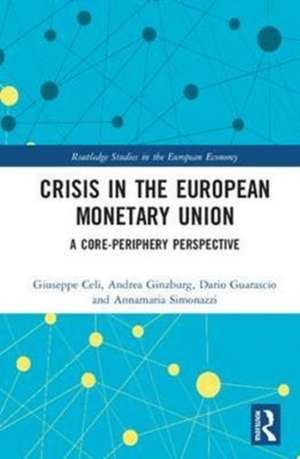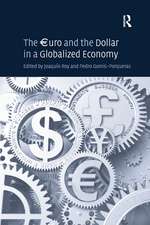Crisis in the European Monetary Union: A Core-Periphery Perspective: Routledge Studies in the European Economy
Autor Giuseppe Celi, Andrea Ginzburg, Dario Guarascio, Annamaria Simonazzien Limba Engleză Hardback – 11 ian 2018
Crisis in the European Monetary Union: A Core-Periphery Perspective provides a new framework for analysing the economic crisis that has shaken the Eurozone countries. Its analysis goes beyond the short-term, to study the medium and long-term relations between ‘core’ countries (particularly Germany) and Southern European ‘peripheral’ countries. The authors argue that long-term sustainability means assigning the state a key role in guiding investment, which in turn implies industrial policies geared towards diversifying, innovating and strengthening the economic structures of peripheral countries to help them thrive.
Offering a fresh angle on the European crisis, this volume will appeal to students, academics and policymakers interested in the past, present and future construction of Europe.
| Toate formatele și edițiile | Preț | Express |
|---|---|---|
| Paperback (1) | 389.38 lei 6-8 săpt. | |
| Taylor & Francis – 12 dec 2019 | 389.38 lei 6-8 săpt. | |
| Hardback (1) | 1058.65 lei 6-8 săpt. | |
| Taylor & Francis – 11 ian 2018 | 1058.65 lei 6-8 săpt. |
Din seria Routledge Studies in the European Economy
-
 Preț: 324.39 lei
Preț: 324.39 lei -
 Preț: 303.89 lei
Preț: 303.89 lei - 20%
 Preț: 148.76 lei
Preț: 148.76 lei - 9%
 Preț: 934.49 lei
Preț: 934.49 lei -
 Preț: 311.41 lei
Preț: 311.41 lei -
 Preț: 316.32 lei
Preț: 316.32 lei - 18%
 Preț: 1057.13 lei
Preț: 1057.13 lei - 16%
 Preț: 338.33 lei
Preț: 338.33 lei - 25%
 Preț: 524.78 lei
Preț: 524.78 lei -
 Preț: 494.48 lei
Preț: 494.48 lei - 26%
 Preț: 764.62 lei
Preț: 764.62 lei -
 Preț: 466.07 lei
Preț: 466.07 lei - 25%
 Preț: 823.63 lei
Preț: 823.63 lei - 18%
 Preț: 1057.09 lei
Preț: 1057.09 lei - 26%
 Preț: 819.48 lei
Preț: 819.48 lei - 26%
 Preț: 846.50 lei
Preț: 846.50 lei - 18%
 Preț: 1049.99 lei
Preț: 1049.99 lei - 18%
 Preț: 1004.20 lei
Preț: 1004.20 lei - 18%
 Preț: 1332.21 lei
Preț: 1332.21 lei - 26%
 Preț: 765.43 lei
Preț: 765.43 lei - 28%
 Preț: 848.15 lei
Preț: 848.15 lei -
 Preț: 223.01 lei
Preț: 223.01 lei - 18%
 Preț: 703.79 lei
Preț: 703.79 lei - 28%
 Preț: 847.50 lei
Preț: 847.50 lei - 18%
 Preț: 699.96 lei
Preț: 699.96 lei - 25%
 Preț: 828.12 lei
Preț: 828.12 lei - 18%
 Preț: 1159.70 lei
Preț: 1159.70 lei - 18%
 Preț: 1174.70 lei
Preț: 1174.70 lei - 18%
 Preț: 1057.89 lei
Preț: 1057.89 lei -
 Preț: 484.47 lei
Preț: 484.47 lei - 18%
 Preț: 711.10 lei
Preț: 711.10 lei - 26%
 Preț: 848.15 lei
Preț: 848.15 lei -
 Preț: 413.13 lei
Preț: 413.13 lei - 26%
 Preț: 849.65 lei
Preț: 849.65 lei - 26%
 Preț: 875.55 lei
Preț: 875.55 lei - 26%
 Preț: 762.57 lei
Preț: 762.57 lei - 18%
 Preț: 1437.35 lei
Preț: 1437.35 lei - 18%
 Preț: 1108.37 lei
Preț: 1108.37 lei -
 Preț: 495.09 lei
Preț: 495.09 lei - 15%
 Preț: 703.48 lei
Preț: 703.48 lei - 31%
 Preț: 763.81 lei
Preț: 763.81 lei
Preț: 1058.65 lei
Preț vechi: 1291.04 lei
-18% Nou
Puncte Express: 1588
Preț estimativ în valută:
202.57€ • 212.26$ • 167.46£
202.57€ • 212.26$ • 167.46£
Carte tipărită la comandă
Livrare economică 11-25 aprilie
Preluare comenzi: 021 569.72.76
Specificații
ISBN-13: 9781138685833
ISBN-10: 1138685836
Pagini: 312
Ilustrații: 104
Dimensiuni: 156 x 234 x 25 mm
Greutate: 0.57 kg
Ediția:1
Editura: Taylor & Francis
Colecția Routledge
Seria Routledge Studies in the European Economy
Locul publicării:Oxford, United Kingdom
ISBN-10: 1138685836
Pagini: 312
Ilustrații: 104
Dimensiuni: 156 x 234 x 25 mm
Greutate: 0.57 kg
Ediția:1
Editura: Taylor & Francis
Colecția Routledge
Seria Routledge Studies in the European Economy
Locul publicării:Oxford, United Kingdom
Public țintă
Postgraduate and UndergraduateCuprins
Introduction, Part 1: A medium term perspective, 1. The current Euro crisis: a faulty institutional construction, 1. Introduction, 2. The Werner Report and the idea of Europe, 3. The Snake and the EMS, 4. The bumpy road to the EMU, 5. The EMU’s institutional flaws, 6. In the crisis: bail-outs, politics, reforms, 7. Conclusions, 2. The European core-periphery divergent development paths before the crisis: 1999–2008, 1. Introduction, 2. Germany: from Europe's sick man to export superstar, 3. Wage moderation, 4. Housing: a ‘non-tradable’ sector?, 5. The construction of the Central European Manufacturing Core, 6. Conclusions, 3. France: the waning of a core country, 1. Introduction, 2. From dirigisme to statist liberalism, 3. The waning of a key sector: the automotive industry, 4. Conclusions, 4. The Eurozone’s double-dip recession: interpretations and policies, 1. Introduction, 2. A standard balance of payments crisis?, 3. The Target2 debate: a stealth bail-out?, 4. The unfolding of the crisis and the role of austerity, 5. The structural impact of the crisis, 6. Conclusions, 5. Inequality, poverty and imports: core, periphery and beyond, 1. Introduction, 2. Rich Germany, poor Germans, 3. Poor Southern Europe, poor Southern Europeans, 4. South of South: the case of the Italian Mezzogiorno, 5. Conclusions, 6. The network of European trade between core and periphery, 1. Introduction, 2. The European trade networks, 3. The structure of trade, 4. The evolution of the automotive industry in Europe, 5. Conclusions. Part II: European de-industrialization processes in a long-term perspective, 7. The weakening of the European growth engine, 1. Introduction, 2. The fading of the golden age, 3. Heterodox explanations of the fall in investment: industry and finance, 4. Orthodox explanations of the fall in investment: secular stagnation, 5. Financialization and Europeanization6. Conclusions, 8. The interruption of industrialization in Southern Europe: a centre-periphery perspective, 1. Introduction, 2. The embeddedness of centre-periphery relations, 3. The global crisis of the mid-1970s in Southern Europe: peripheral tertiarization and impoverishment of the productive structures, 4. The European integration of a latecomer country: Italy, 5. The late-latecomers’ European integration, 6. Democratic transition and restructuring without re-industrialization, 1975–1985, 7. The financialization of the European periphery, 8. The German internationalization strategy: 'widen the market and narrow the competition', 9. Conclusions, 9. A policy divide: industrial policies in the ‘core’ and ‘peripheral’ countries, 1. Introduction, 2. The vicissitudes of a concept, 3. European industrial policy, 4. The Investment Plan for Europe (Juncker Plan), 5. Industry 4.0: a Europe-wide opportunity or a new factor of divergence?, 6. Conclusions, 10. Conclusions, 1. Institutional flaws and policy mistakes, 2 Structural differences, 3 Partial, cautious reforms, 4 Institutional reforms, 5 A German Europe, 6 A European Germany, 7 A longer-term perspective, 8 Income distribution and the European social model for long-term sustainability, 9 Towards a shared alternative programme
Notă biografică
Giuseppe Celi is Associate Professor of Economics at the University of Foggia, Italy. He has been the coordinator of the university’s Economic Theory PhD programme.
Andrea Ginzburg was Professor of Economic Policy at the University of Modena and Reggio Emilia, Italy.
Dario Guarascio is a researcher in applied economics at the National Institute of Public Policy Analysis (INAPP), Italy. He is in charge of the research unit 'Skills and labour market transitions'.
Annamaria Simonazzi is Professor of Economics at La Sapienza University of Rome, Italy. She is co-editor of Economia & Lavoro and on the editorial board of inGenere.
Andrea Ginzburg was Professor of Economic Policy at the University of Modena and Reggio Emilia, Italy.
Dario Guarascio is a researcher in applied economics at the National Institute of Public Policy Analysis (INAPP), Italy. He is in charge of the research unit 'Skills and labour market transitions'.
Annamaria Simonazzi is Professor of Economics at La Sapienza University of Rome, Italy. She is co-editor of Economia & Lavoro and on the editorial board of inGenere.
Descriere
After decades of economic integration and EU enlargement, the economic geography of Europe has shifted, with new peripheries emerging and the core showing signs of fragmentation. This book examines the paths of the core and peripheral countries, with a focus on their diverse productive capabilities and their interdependence.








